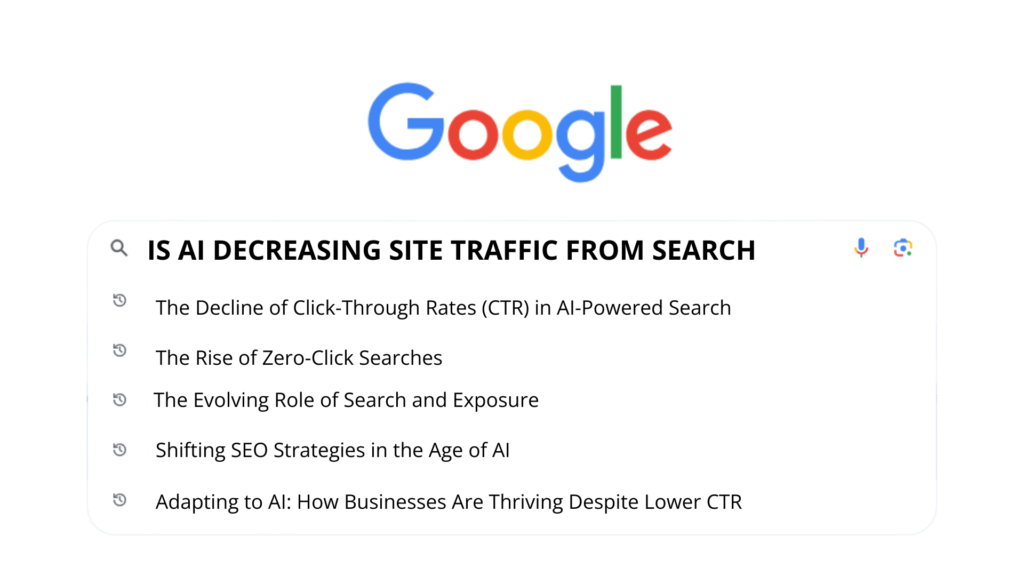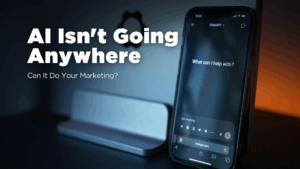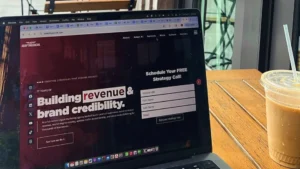Search engines are changing faster than ever, and AI-generated answers are reshaping how users find information. Instead of clicking on websites, many now get their answers instantly from AI-powered summaries like Google’s AI Overview (SGE) and Bing Copilot. This shift is dramatically reducing click-through rates (CTR), leaving businesses and content creators questioning the future of search traffic.
But does lower CTR mean SEO is dead? Not necessarily. As AI takes center stage, traditional success metrics are evolving, and visibility may matter just as much as clicks. The way brands approach search needs to change—but those who adapt can still thrive.
The Decline of Click-Through Rates (CTR) in AI-Powered Search
AI-generated responses are significantly reducing the number of clicks search results receive. When Google’s AI Overview (SGE) appears, organic CTR can drop by up to 70%, falling from around 2.94% to just 0.84%. Paid search ads aren’t immune either—CTR for paid listings nearly halves, decreasing from 21% to 10% when AI-generated answers are present. Users increasingly rely on AI to deliver instant responses, reducing the need to visit external websites.The impact varies across search types, but the trend is clear: fewer users are clicking traditional links. A study analyzing 10,000 informational queries found that organic CTR dropped from 1.41% to 0.64% when AI responses were present, while queries without AI-generated answers saw organic CTR increase. As search engines prioritize AI summaries, businesses that once thrived on search traffic must now adapt to a world where ranking high doesn’t guarantee clicks.
The Rise of Zero-Click Searches
AI-powered search isn’t just lowering CTR—it’s accelerating the rise of zero-click searches, where users get answers directly on the search results page without visiting any website. By 2024, nearly 60% of Google searches in the U.S. ended without a click, a number that continues to grow as AI-generated answers become more common. Google’s AI Overview (SGE) was shown in up to 84% of queries during testing, meaning fewer opportunities for websites to attract traffic.
This shift has major implications for brands and content creators. A recent analysis estimated that AI-generated results could cause an 18%–64% drop in organic traffic for some websites. Instead of driving users to external pages, search engines are keeping them within their ecosystem, using AI-generated content to answer queries instantly.
While this presents challenges, it also creates new opportunities—businesses that optimize their content to be featured in AI summaries can still gain valuable exposure, even if direct clicks are lower.
The Evolving Role of Search and Exposure
With AI-generated responses reducing direct clicks, impressions—how often a brand or page appears in search results—are becoming a more critical metric. Even if users don’t click, being featured in AI overviews keeps brands visible and builds credibility.
Google’s Vice President Philipp Schindler has emphasized that links appearing in AI-generated answers often receive more engagement than they would as standard organic listings because users perceive them as more relevant and authoritative . Similarly, Sundar Pichai, Google’s CEO, has argued that AI-driven summaries enhance user experience by providing context before a click, which can lead to higher engagement and more valuable interactions when users do choose to visit a website .
As a result, marketers are shifting their focus from raw CTR to broader visibility metrics like impression share, brand awareness, and post-click engagement. Rand Fishkin, founder of SparkToro, has pointed out that zero-click searches now account for nearly 60% of Google queries, reinforcing the need to track impressions rather than just clicks .
This trend extends to paid search as well. According to experts at Seer Interactive, businesses are prioritizing return on ad spend (ROAS) and impression share over CTR, recognizing that AI-driven summaries mean fewer total clicks but potentially more qualified visitors. Lily Ray, SEO Director at Amsive Digital, has also advised businesses to optimize for AI-driven visibility by ensuring their content is cited within AI-generated answers, which she describes as “the new featured snippet” for maintaining relevance and authority despite declining click volume .
In essence, the search game is shifting: clicks alone are no longer the sole success metric. Instead, appearing frequently in AI-generated results is now key to long-term brand visibility, trust, and influence in search.
Shifting SEO Strategies in the Age of AI
As AI-generated answers take over search results, SEO is evolving beyond ranking #1. The new focus? Ensuring your content is selected for AI-generated responses—a strategy some call Generative Experience Optimization (GEO).
Here’s how businesses are adapting:
Creating In-Depth, AI-Friendly Content
- Example: Flyhomes expanded their real estate guides to align with AI-driven search behavior, leading to a 10,737% increase in traffic in just three months.
Leveraging User-Generated Content
- Example: Brainly optimized user-generated Q&A content, tripling their keyword rankings and increasing the likelihood of being cited in AI responses.
Targeting Multi-Format SEO
- Example: ZOE & Typeform optimized for image search, featured snippets, and People Also Ask (PAA) results, all of which AI tools frequently pull from.
The takeaway? SEO isn’t dead—it’s evolving. Brands that adjust their strategy to get featured in AI-generated answers will maintain visibility, even if CTR declines.
Adapting to AI: How Businesses Are Thriving Despite Lower CTR
Even as organic clicks decline, businesses are finding new ways to stay relevant in AI-driven search. Instead of chasing traditional rankings, they are focusing on visibility, engagement, and conversion optimization. Here’s how smart brands are adapting:
1. Prioritizing Post-Click Engagement
With fewer total clicks, the focus has shifted to making each visit count. Users who do click after seeing an AI-generated summary are often more informed and closer to taking action. Conductor, an SEO SaaS company, saw a 60% drop in traffic after AI overviews launched, but conversions remained stable—proving that higher-intent visitors can offset lower click volume.
2. Scaling AI-Friendly Content Production
Brands are creating structured, in-depth content that AI can easily pull into summaries. This includes using clear headers, concise explanations, and schema markup to make content more digestible for AI. Monday.com embraced this strategy, publishing 1,000 SEO-focused articles in one year, driving significant organic revenue despite declining traditional rankings.
3. Diversifying Traffic Sources
Relying solely on Google is riskier than ever. Businesses are strengthening social media presence, email marketing, and direct engagement strategies to reduce dependence on search traffic. Omnisend, an e-commerce marketing platform, built a multi-channel strategy and now earns ~200,000 organic clicks per month, proving that a diversified approach is key to long-term visibility.
SEO success isn’t just about ranking anymore—it’s about adapting to AI-driven search and making every impression and click more valuable.

Embracing AI-Driven Search: The Future of SEO & Digital Visibility
AI-generated responses from Google (SGE/AI Overviews), Bing (Chat/Copilot), and other platforms are transforming search, leading to a decline in organic CTR. The traditional goal of ranking #1 now means appearing inside an AI summary rather than just in blue-link results. To stay competitive, businesses must adapt by tracking impression share, optimizing for AI-driven answers, and shifting KPIs beyond just clicks to include brand visibility and conversions.
The future of search will be a hybrid of AI-generated answers and traditional SEO. Success will come from blending classic SEO tactics—technical optimization, high-quality content, and schema markup—with Generative SEO strategies, such as structuring content for AI summaries and establishing authority. Rather than fearing lower CTRs, businesses should pivot their SEO approach to ensure their content is the one AI pulls from, securing ongoing visibility and engagement.
At Adapting Social, we help brands navigate these search changes with data-driven strategies tailored for the AI era. From optimizing content for AI-driven search to crafting high-converting campaigns across multiple channels, we ensure your business stays ahead of the curve.
Ready to future-proof your digital marketing? Let’s adapt and grow together.




